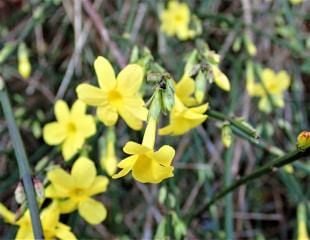
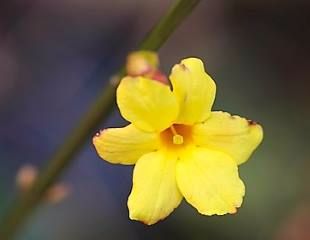
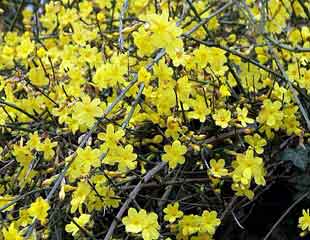
How to grow Winter flowering Jasmine
Key Facts:
Height: up to 3m wtih arching branches forming a mound
light: sun or partial shade
Soil: Any reasonable
Maintenance: none required, fully hardy
Special Features:
Winter-flowering Jasmine is a deciduous perennial which has yellow flowers from November to March. It is a tough shrubby plant, which will climb and tumble down over walls and fences. Its Latin name, Jasminum nudiflorum, describes the flowers on bare branches that appear ahead of the foliage. Although commonly described as a climbing plant, it has no tendrils and is not very self supporting; it is more of shrubby scrambler than a climber. It has long, arching branches which will go over a fence or wall.
Where to plant Winter flowering Jasmine
One advantage of growing winter-flowering Jasmine is its tolerance of a wide range of growing conditions, which makes it useful to grow in a tough spot. Winter flowering Jasmine will grow in any soil, acid or alkaline, poor soil, cold areas and in semishade. Although it flowers best in sun, it will grow pretty well anywhere. Winter-flowering Jasmine needs little attention, and it does not demand pruning. However, pruning improves it, but prune it at the right time; see below.
Winter-flowering Jasmine is deciduous with dark green leaves, which appear after flowering around April, lasting to around October. The leaves tend to be sparse. Unlike other Jasmines (not all of which are fully hardy), it lacks scent. In common with many climbing plants, Winter flowering Jasmine is vigorous.
Because the leaves are sparse, it can look a bit untidy when not in flower. To mask this problem, plant with an evergreen shrub or an evergreen climber such as Ivy. As a combination, Ivy and Jasmine are tough and tolerant of soil types, and semi shade and would be ideal for a difficult spot in the garden. It is also suitable for growing in a coastal garden. It is trouble and pest free.
Pros and Cons of growing Winter Jasmine
Pros:
Tolerant of a wide range of soils and semi-shade
Maintenance-free and fully hardy
Provides colour and interest during autumn and winter
Yellow flowers are attractive
Grow it as a hedge (see below).
Cons:
vigorous, it can be hard to contain with pruning.
Leaves are sparse and can look a bit untidy when not in flower. This can be ameliorated by planting with an evergreen shrub or climber, such as ivy.
Spreads quickly, forming as branches touch the ground, making it hard to eradicate.
Not self-supporting.
Winter flowering Jasmine as a Hedge

Winter-flowering Jasmine can be trained into an attractive hedge. You can see in the image that the winter-flowering Jasmine looks neat, with a good amount of flowers, compared to the image below of a neglected plant.
Whilst winter flowering jasmine is undoubtedly easy to grow, it's vigorous and unfussy. To keep it looking good and with plenty of flowers, it needs a regular pruning after flowering. When grown as a hedge, it is subject to a regular prune and I think it looks much better for it.
How and when to prune Winter Jasmine
Golden Rule: Always prune after flowering.
Winter flowering Jasmine can get messy, with tangled stems, as shown in the image below. To overcome its untidy habit, pruning will help to keep it in shape. Jasmine is group 2 for pruning, which means to prune only after flowering in early spring. It flowers on "old wood" (what does this mean?) The flowers form on branches that grew last year. Prune immediately after flowering or cut off the branches on which next year's flowers are forming, see below.
Take out any diseased or spindly branches and thin out the whole plant if it is becoming too large. You can safely take out up to 20% of the plant growth annually.
If Jasmine has become overgrown or exceeded its allotted space, you can prune it hard to 60 cms. This may mean little or no flowers for the first year or so until it regrows.
Winter Jasmine will brighten up the gloomy corners of the garden in winter. It looks good planted with variegated evergreen shrubs such as Euronymous fortunei "emerald n gold" or Elaeagnus ebbingei "Gilt Edge". The yellow of the jasmine chimes well with the gold-coloured variegations.
Wrongly pruned Winter Flowering Jasmine
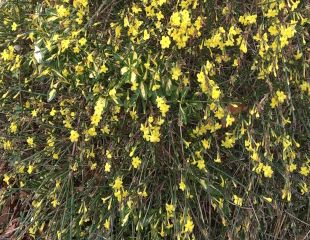
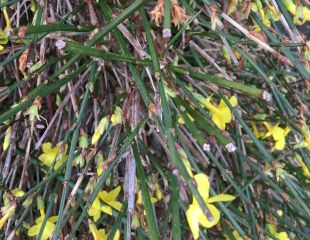
The two images above are the same Winter flowering Jasmine, taken at the same time. At first glance, the image on the left doesn't look too bad, with quite a lot of flowers. The close-up image on the right shows many cut branches without flowers.
Almost certainly, this shrub was pruned at the wrong time. If, like this shrub, it is pruned at the wrong time, late in the year, the act of pruning cuts off many of the flowering bearing shoots. In the photo has some flowers, but it would have flowered much more if every shoot carried flowers. When a shrub "flowers on old wood" timing is important.
What happens if I don't prune winter flowering Jasmine?

This image shows a neglected winter-flowering Jasmine that no one pruned and that was left alone. It has become spindly, and some areas are bare, without flowers.
At best, Jasmine tends to grow straggly, and it looks better combined with an evergreen climber, which covers its spindly habit and bare patches. Pruning will also help. Take out all the dead growth and prune regularly into a neat shape after flowering. I inherited this specimen, and if I keep it, I will give it a hard, renovating prune, removing all dead wood and cutting it back to around 40-50cms from the base.

Given that Jasmine is easy to grow, tough and not fussy about its growing conditions, I have classified as a green wheelbarrow plant.
